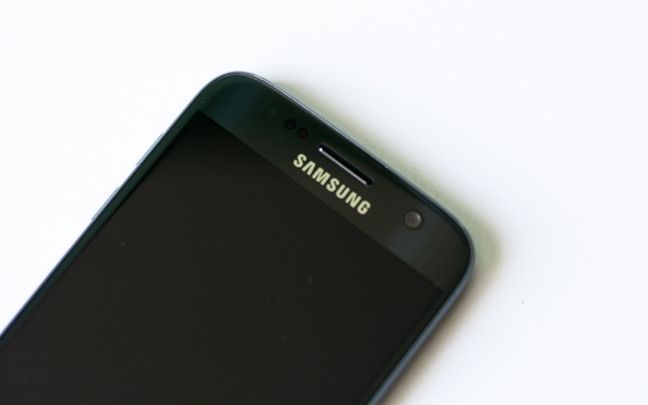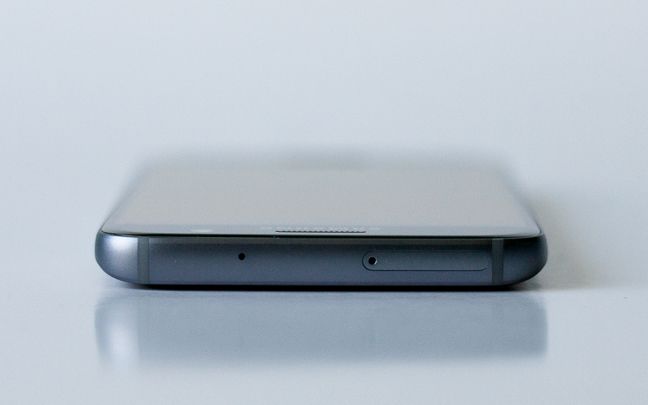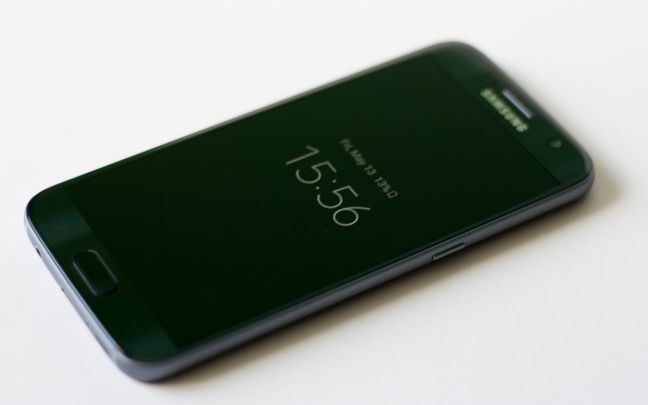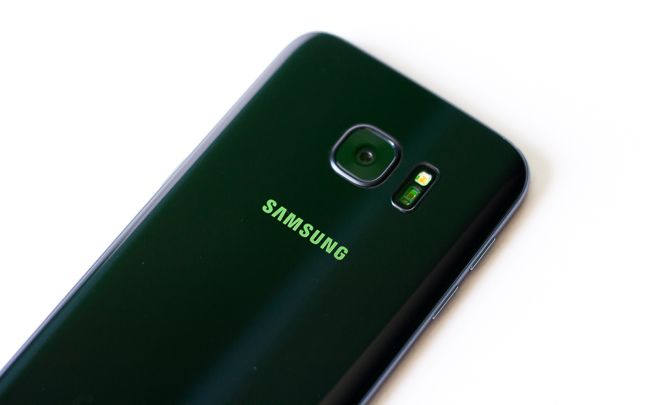
The release of a new Samsung Galaxy smartphone generates such hype that it can only be compared to an iPhone release: everyone's excited about the new features and many want to get the latest installment in the long-running Galaxy series. After owning a Samsung Galaxy S2 for many years, I have been disappointed by the S3-S4-S5 line, so I have completely abandoned Samsung smartphones and was genuinely interested in what the Galaxy S7 could bring to the table. In s hort, I have been surprised. Read our review to learn everything you need to know about the Samsung Galaxy S7:
Hardware specifications and packaging
Samsung doesn't seem to waste too much time on the packaging of its flagship smartphone: the Samsung Galaxy S7 comes in a simple, black cardboard box that is not very elegant nor minimalistic, but at least it looks OK. It has the model name and storage space printed on its front, with the model's color on the right side, plus you also get a shiny blue warranty sticker too.
The cardboard box is magnetically sealed and opens up to reveal the smartphone itself, placed on top of the package. Under the device there is a piece of cardboard - when taken out you can see all the other accessories bundled with the smartphone: a charger head, a microUSB cable, a USB OTG adapter and a headset in a small plastic case.
Although there is no smartphone case bundled with the Galaxy S7, the number of accessories is still quite generous: the headset has its own nice little case that can be very handy, as the headset's cable won't get tangled up. The OTG adapter is another nice bonus: it can be used to connect the Samsung Galaxy S7 to your previous smartphone and instantly transfer all your personal data, or you can even connect a mouse or a keyboard to your device if you need to.
Of course, the most interesting thing inside the package is the smartphone itself: when you take it into your hand you just feel quality. The cold, brushed metal back fits perfectly in an average-sized palm and it simply gives the feeling of a perfect size. Besides that, it's also obvious that the smartphone is made of very high quality materials and it is very solid. It won't fall apart for sure. 🙂
Its design is quite elegant, especially the Black Onyx edition which we had for testing. This is the first current-gen smartphone that is really black, not some dark silver color and it looks incredibly good. Of course, if you prefer something more extravagant, you might want to get a Pink Gold edition, or something from in between, like White Pearl, Gold Platinum or Silver Titanium.
Let's see what the Samsung Galaxy S7 has to offer on the technical side of things:
Its display is a 5.1" Super AMOLED touchscreen with a resolution of 1440 x 2560 pixels - that means a rocking 577 ppi pixel density. The screen is protected with a layer of Corning Gorilla Glass 4 coating, so you don't have to worry about getting it scratched. The S7 is not a very large smartphone: it's 5.61 inches or 142.4 mm tall, 2.74 inches or 69.6 mm wide and it has a thickness of only 0.31 inches or 7.9 mm. At this size it weighs 5.36 oz or 152 grams, which is mostly due to the high quality metals used in the device. It's not very much, we are sure that it won't be annoying.
As for the heart of this flagship smartphone, we have to say that it has more than one. This means that the Samsung Galaxy S7 comes in two flavors: the US edition is equipped with a Qualcomm MSM8996 Snapdragon 820 chipset that has two 2.15 GHz and two 1.6 GHz Kryo cores, while if you live outside the US, you will get the other edition that comes with the Samsung Exynos 8890 Octa-core chip, using a quad-core, 2.3 GHz Mongoose processor and a quad-core 1.6 GHz Cortex-A53 CPU. Both versions use 4 GB Dual-channel LPDDR4 RAM, although the US version is slightly faster, ticking at 1866 MHz, compared to the non-US speed of 1974 MHz.
The graphical processor is also different in the two chipsets: the US edition the 624 MHz Adreno 530 GPU, while the non-US variant is equipped with a Mali-T880 MP12 graphical processing unit, both having DirectX 11.1, OpenCL 1.2 and OpenGL ES 3.1 support. And just to let you sleep tight tonight: no matter which variant you get, the system performance is almost exactly the same on the two models, so don't worry about the technicalities.
Although you won't really get to see which model are you buying of the previous two, you can still choose based on storage space, as the Galaxy S7 comes with 32 or 64 GB of space. If that seems small, you can extend it , as you can install a microSD card of up to 200 GB in size. You won't really be able to install most apps on a microSD card, but we're sure that it will be great for large files, like your music or videos.
Another variation for the Samsung flagship device is that it comes in both Single SIM and Dual SIM editions. The first one has a nano-SIM slot and another dedicated for the microSD card, while the latter can use two nano-SIM cards, or a single nano-SIM and a microSD card, taking up the second SIM slot. The Dual SIM edition uses dual standby technology, meaning that while you're talking on one SIM card, the other one is in standby, not able to receive calls. Both SIM slots have 4G support, although only one can connect to these high-speed networks at a time.
The device's battery has a non-removable, Li-Ion battery with an impressive capacity of 3000 mAh. Based on our tests it won't really be a problem that you can't get the battery out, as it has a really good standby time - but more on that later.
Samsung Galaxy S7 has two cameras. The primary, rear-facing camera has a resolution of 12 MP, an aperture size of f/1.7, phase detection autofocus, optical image stabilization and a LED flash. It can record 2160p videos at 30fps, 1080p videos at 60fps and 720p videos at a super-slow speed of 240fps. The front camera is a 5 MP module with the same f/1.7 aperture size and has auto HDR to enhance image quality.
As for connectivity, there is nothing the Samsung Galaxy S7 cannot handle: it supports all networks from 2G to LTE, although the specific frequencies are not mentioned in its online specifications, as neither are the theoretical maximum speeds on 4G networks. The device can connect to all kinds of WiFi networks (802.11 a/b/g/n/ac), has dual-band WiFi (supporting both 2.4 GHz and 5 GHz networks), supports WiFi Direct and can be used as a WiFi hotspot. It is also equipped with a Bluetooth 4.2 chip with A2DP, LE and aptX support, it has GPS module with A-GPS, GLONASS and BDS support, a microUSB 2.0 port (with OTG support), a 3.5 mm audio jack and an NFC chip. Although there is no FM radio in this smartphone, it has some other nice additions, like the heart rate monitor on the back panel, or the fingerprint reader on the Home key.
The full set of hardware specifications can be found here: Samsung Galaxy S7 specifications.
If you just take a look at its specs, it becomes quite clear that the Samsung Galaxy S7 is no small-time player: it's loaded with the latest and greatest hardware, has some really good extras and comes in a size that will probably be a perfect match for the hands of many.
Design and build quality
As I have previously noted, I haven't really been a fan of Samsung's smartphone designs during the Galaxy S3-S5 period. Somehow I always felt that I was holding something very fragile in my hands, that could break at any given moment. This is absolutely not true for the Galaxy S7: it has very sleek curves, a simplistic design, that is somewhere on the border between elegant and a bit sporty.
Most of its front panel is taken up by the 5.1" screen, that nearly goes edge to edge: of course the only things missing are the curved sides from Galaxy S7 Edge, but if you are not used to having those, you will be absolutely fine without them, it's not such a big deal to spend the price of an entry-level smartphone on that. Right above the screen we can see the light and proximity sensors, as well as the frontal, 5 MP camera, the phone speaker and the manufacturer's logo, while below the display there is a physical Home key, which also houses a fingerprint reader. There are two softkeys on the sides of the Home key, but these are invisible until needed.
The bottom edge is quite crowded: from left to right there is the 3.5 mm jack, a microUSB 2.0 port (with OTG support), the primary microphone and the loudspeaker. Also, these connectors are placed between two pieces of plastic that are supposed to be a small addition to the all-steel case. These look quite similar to the ones on the sides of the iPhone 6 and we honestly don't understand why they were necessary. They might give the impression of the front of a sports car, but also feel like some cheaper materials. It's also interesting to note, that although the microUSB and the jack ports are not sealed, the Samsung Galaxy S7 is IP68 certified, which means that it's completely protected against dust and can be continuously immersed in up to 3 meters of water. If water penetrates these connectors, the device warns the user not to connect anything to it until it's dried.
There is much less to see on the top edge, we only have the secondary microphone and the SIM slot: in case of a Single SIM model, there is a tray for a nano SIM card inside, or if you have a Dual SIM model, the tray has place for two nano SIM cards, or a nano SIM and a microSD card. The two pieces of plastic are present on this edge as well.
The two sides are not empty either: there is a single button on the right edge, which is used to turn the smartphone or the display On and Off, while on the right side there are two keys to control the volume.
This a classical button layout and it is proven to be one of the most effective and user-friendly.
The back panel is clearly dominated by the presence of the large, 12 MP main camera, which can be seen in the center of the topmost part. Near the camera there is a LED flash and another sensor, which turns out to be an optical heart-rate monitor.
Remember when using this, that optical heart rate sensors are still considered new technology and are not 100% accurate, and neither are medical devices, so don't rely on data from them for medical purposes. Below the camera there is another Samsung logo, while on the bottom of the back panel there is some obligatory manufacturing information that is barely visible.
As for the smartphone's build quality we have to say that we are very impressed. Holding the Samsung Galaxy S7 in your hand feels like holding something that has been crafted to perfection. We really don't like to use superlatives, but it just feels like a very solid, long-lasting construction. Although the material it's made from can be a bit slippery, the device is not too large, so we don't think it will fall out of your palm.
The screen is very bright and - as usual for Samsung smartphones - with a high contrast. This might even seem a bit too much for some, but it can be fine-tuned from the settings. It is a 2.5K (QHD) screen with a resolution of 2560 x 1440 pixels and a 577 ppi pixel density. It is great to look at, has superb brightness, no matter what lighting conditions you use it in. It is an "Always on" display, meaning that the current date and time are always displayed onscreen, even if you turn the display off. This barely uses any power and it's a great idea, but it can be a bit annoying, as the time display is moved on the screen periodically to avoid burn-in.
Samsung's design team did a great job with the Galaxy S7: it feels very compact, it has no annoying design features, it's made of very high quality materials and it's practically blessed with a screen that is a marvel of current technology.
The smartphone experience on the Samsung Galaxy S7
The Galaxy S7 is not the most expensive smartphone from Samsung, but its price is still rather high. Considering that and the hardware it's packed with, we are clearly looking at a high-end flagship smartphone. If the specifications and the build quality didn't convince you, it's time to turn on the device.
The first thing you'll notice is the crystal clear screen which we already praised, but we must say again that it looks darn good to look at so many pixels crammed in such a tight space. The second thing you will surely take note of is the speed of the smartphone: the hardware is very powerful, there is really no chance to see any lags, screen tears or slowdowns. The Samsung Galaxy S7 has one of the best available mobile processors and it's packed with lots of RAM and accompanied by a good graphics chip. All in all, speed won't be an issue at all. Say goodbye to loading times or long waits.
Although making phone calls seems to be one of the least popular activities on today's smartphones, we are still talking about a phone, so sound and call quality should be top-notch. All calls were very clear, we had no problems hearing others and others heard us perfectly as well.
Network connectivity shouldn't be an issue on any modern device, and it isn't on the Galaxy S7 either: the smartphone had no issues connecting to the 4G network and the connection was always stable, we didn't experience any problems with it. It's good to know that if you opt for the Dual SIM model, you can have 4G access on any of the two SIM cards, but only one of them will be able to use a high-speed network, the other being limited to calls and text messages.
WiFi, Bluetooth connectivity and navigation all worked like a breeze. The 5.1 inch screen is considered to be average nowadays, but it's big enough to watch a movie and it can also be a superb companion during your travels, if you use it for GPS navigation.
The Samsung Galaxy S7's official specifications doesn't list the expected standby or call times, although, according to GSMArena , you should be able to talk for 22 hours on a 3G networks or play music for 62 hours. We're not really fans of day-long chit-chats or never ending house parties, but we must say that the 3000 mAh battery was fairly impressive: it kept the Galaxy S7 ticking for over two days. Nowadays we're content with a smartphone that doesn't need to be charged every day, so this is a really good result. As usual, we were using the smartphone with its default settings: automatic brightness, always-on WiFi, disabled Bluetooth and the location set to battery saving mode. Add to this an average number of phone calls, messages, email and quite a lot of web browsing and those two days on battery are even better.
Charging is another thing: be sure to keep the original charger intact as the Samsung Galaxy S7 supports quick charging, which means that your device will be charged from 0 to 100 in an hour and a half or so. Yep, that's really fast, but be wary that the smartphone can get a bit hot during fast charging. The Samsung Galaxy S7 also supports wireless charging, but you need to get a wireless charger separately for that.
When you buy a flagship smartphone from a major manufacturer, you expect it to work flawlessly and the Samsung Galaxy S7 does exactly that. It has a great screen, it's faster than most current smartphones on the market, has no connectivity problems, has an uptime of over two days, can be charged quickly and it lacks important software bugs.
Read the next page of this review to learn more about the camera experience on this smartphone as well as the performance it offered in benchmarks.


 28.05.2016
28.05.2016 















